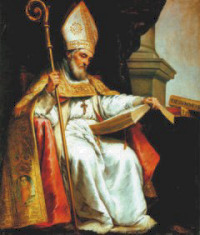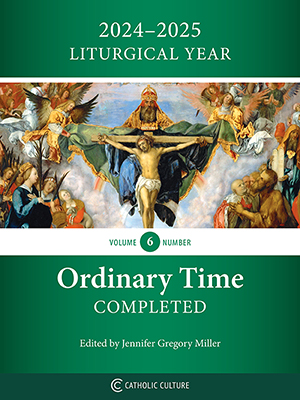Lent: April 4th
Saturday of the Fifth Week of Lent; Optional Memorial of St. Isidore, bishop and doctor
Other Commemorations: St. Francisco Marto (RM)
» Enjoy our Liturgical Seasons series of e-books!
St. Isidore, who succeeded his brother St. Leander as Archbishop of Seville, was one of the great bishops of the seventh century. He was proficient in all brances of knowledge and was regarded as one of the most learned men of his time; with Cassiodorus and Boethius he was one of the thinkers whose writings were most studied in the Middle Ages, St. Isidore died in 636. Pope Innocent XIII canonized him in 1722 and proclaimed him a Doctor of the Church.
St. Isidore of Seville
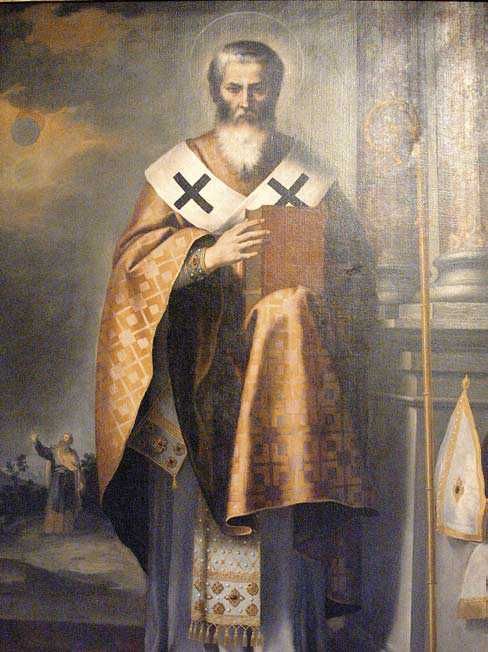 Saint Isidore, bishop of Seville and Doctor of the Church, had the phenomenal versatility of a Leonardo da Vinci. Like that famous Renaissance genius, he had an amazing store of information, including, among other things, a knowledge of history, science, natural history, literature, and philosophy.
Saint Isidore, bishop of Seville and Doctor of the Church, had the phenomenal versatility of a Leonardo da Vinci. Like that famous Renaissance genius, he had an amazing store of information, including, among other things, a knowledge of history, science, natural history, literature, and philosophy.
Isidore's parents gave four children to the Church: Leander, Fulgentius, and Isidore became bishops, Florentina became an abbess; all four were eventually canonized saints. Born about 560 at Cartagena, Spain, Isidore was educated by his elder brother, Archbishop Leander, in the cathedral school of Seville. He had always been a poor student until one day, when he was skipping school, he sat down near the edge of a spring and noticed some grooves worn into the rock. Discovering that the grooves were caused by the constant flow of water, he decided that, similarly, the continual repetition of lessons might make a permanent impression on his memory. After that, Isidore disciplined himself to long hours of study, and in a short time he mastered Latin, Hebrew, and Greek.
On March 13, 599, after Leander's death, Isidore succeeded to the see of Seville. The Visigoths (Germanic invaders) had controlled Spain for several centuries, and at that time their barbarous influence was threatening to destroy Spanish civilization. By using every educational and religious means at his disposal, Isidore converted the Visigoths from Arianism to Catholicism, thus unifying the faith of the nation. He also helped to eradicate the acephalite heresy (it professed that the human and divine natures in Christ are identical), encouraged monasticism, and strengthened religious discipline everywhere. Isidore guided the course of three synods and presided over the Fourth Council of Toledo, held in 633. There it was decided, under Isidore's influence, to establish a school in each diocese where the clergy could be trained in the liberal arts, and in Hebrew, Greek, medicine, and law.
Isidore was the first Christian writer to attempt compiling a summation of universal knowledge, an encyclopedia. His work, called Etymologies or Origins contained in compact form all the knowledge of his age. It preserved many fragments of classical learning in a way that was intelligible to the Germanic peoples of his time. This contribution to the field of education gained for Isidore the title "Schoolmaster of the Middle Ages," and until the middle of the sixteenth century his Origins remained a favorite textbook. He also rendered a great service to the Church in Spain by completing the Mozarabic missal and breviary begun by Saint Leander.
Isidore was as outstanding in the practice of charity and mortification as he was in the cultivation of knowledge. His house was continually crowded with the poor of the countryside. Shortly before he died, he went to church and, covering himself with sackcloth, had ashes placed on his head. Thus dressed as a penitent, he prayed earnestly for the forgiveness of his sins and gave all his possessions to the poor. He died a short time later, on April 4, 636.
—The Lives of the Saints for every day of the year, Vol. 1: January-April
Patronage: computer technicians; computer users; computers; the Internet; schoolchildren; students; Cartagena, Spain
Symbols and Representation: Bees; bishop holding a pen while surrounded by a swarm of bees; bishop standing near a beehive; old bishop with a prince at his feet; pen; priest or bishop with pen and book; with Saint Leander, Saint Fulgentius, and Saint Florentina; with his Etymologia.
Highlights and Things to Do:
- Listen to Catholic Culture's "Way of the Fathers" episode: 55—Isidore of Seville: Last of the Red-Hot Latin Fathers by Mike Aquilina.
- Read more about St. Isidore:
- For those who speak or read Latin and are fascinated by words you might take a look at The Etymologies.
- From the Catholic Culture library, Pope Benedict XVI's audience text: St. Isidore.
St. Francisco Marto
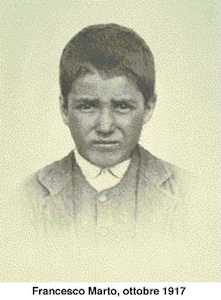 Between May 13 and October 13, 1917, three children, Portuguese shepherds from Aljustrel, received apparitions of Our Lady at Cova da Iria, near Fatima, a city 110 miles north of Lisbon. At that time, Europe was involved in an extremely bloody war. Portugal itself was in political turmoil, having overthrown its monarchy in 1910; the government disbanded religious organizations soon after.
Between May 13 and October 13, 1917, three children, Portuguese shepherds from Aljustrel, received apparitions of Our Lady at Cova da Iria, near Fatima, a city 110 miles north of Lisbon. At that time, Europe was involved in an extremely bloody war. Portugal itself was in political turmoil, having overthrown its monarchy in 1910; the government disbanded religious organizations soon after.
At the first appearance, Mary asked the children to return to that spot on the thirteenth of each month for the next six months. She also asked them to learn to read and write and to pray the rosary “to obtain peace for the world and the end of the war.” They were to pray for sinners and for the conversion of Russia, which had recently overthrown Czar Nicholas II and was soon to fall under communism. Up to 90,000 people gathered for Mary’s final apparition on October 13, 1917.
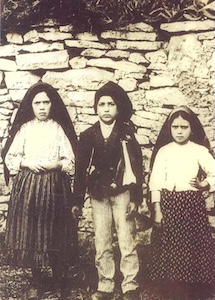
—Excerpted from Saint of the Day: Lives, Lessons and Feast by Leonard Foley, O.F.M.; revised by Pat McCloskey, O.F.M.
Highlights and Things to Do:
- Learn more about St. Francisco:
- Visit virtually the Shrine of Our Lady of Fatima in Fatima, Portugal.
- Read online Fatima in Lucia's Own Words.
- Catholic Cuisine for some food ideas for St. Francisco.


